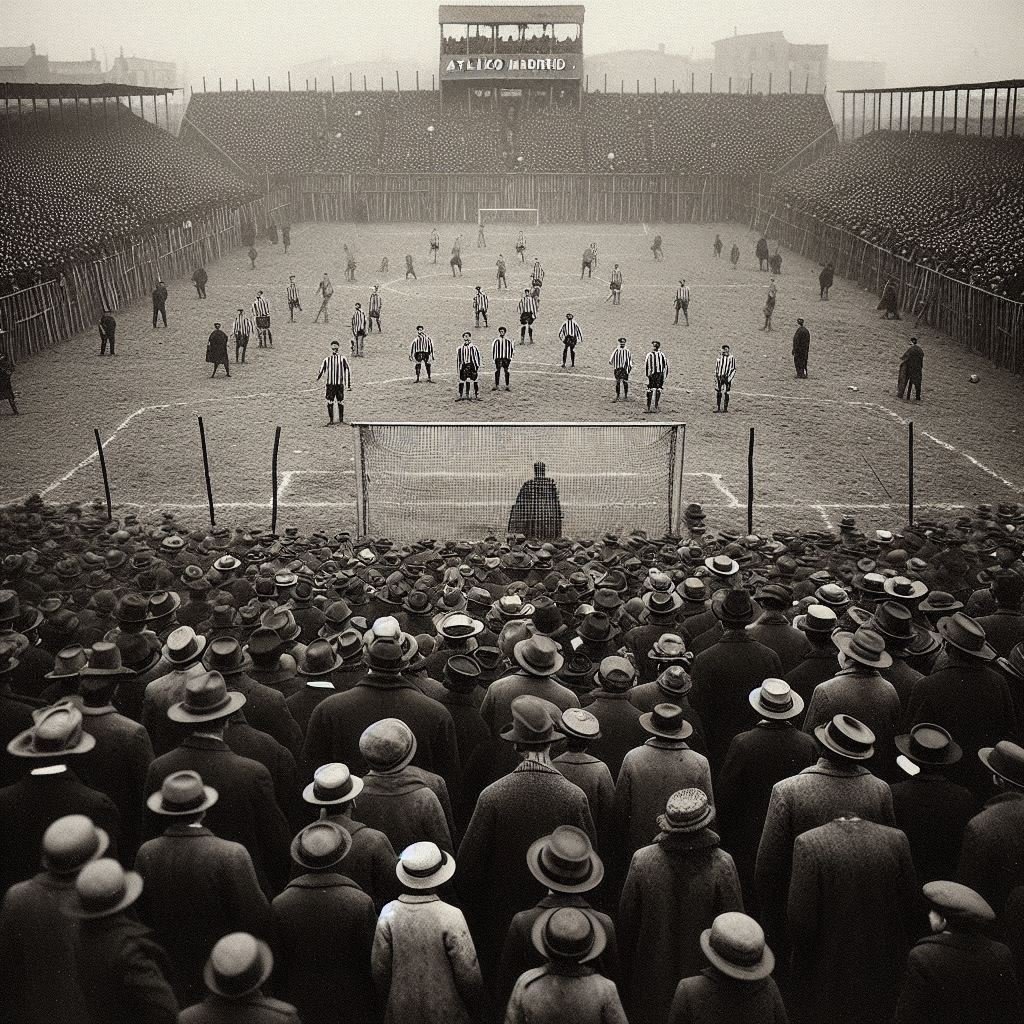Understanding Atlético Madrid’s Iconic Nickname: “Los Colchoneros”
Atlético Madrid, one of Spain’s most celebrated football clubs, has earned various nicknames throughout its history, but none are as iconic as “Los Colchoneros,” or “the Mattress Makers.” This unique nickname, “Mattress Makers,” encapsulates the club’s rich history, unwavering spirit, and curious connection to their iconic red-and-white striped jerseys. We’ll delve into the historical, cultural, and social factors that have contributed to this distinctive identity.
A Humble Beginning in the Heart of Madrid
A group of Basque students established Athletic Madrid in 1903, aiming to create an independent team distinct from Athletic Bilbao. In its early years, Atlético Madrid faced numerous financial challenges, functioning without wealthy sponsors or the privileges associated with elite clubs. The team trained on modest grounds, far removed from the luxurious stadiums of modern football. Despite these hardships, the players’ passion for the sport and the club’s connection to Madrid’s working-class communities helped the team gain a loyal fanbase.

A Tale of Stripes: Necessity, Identity, and the Red and White
In its early days, Atlético Madrid sported blue and white stripes, mirroring the style of Athletic Bilbao. However, in 1911, a shift occurred. The club adopted the iconic red-and-white striped kit we recognize today. Economic limitations, rather than fashion trends, prompted this change. Red-and-white fabric, commonly used in mattress production, was more affordable and accessible. A local factory provided these materials at a lower cost, allowing Atlético to outfit their team without breaking the bank.
This practical decision had a profound impact on the club’s identity. The red and white stripes became synonymous with Athletic Madrid, symbolizing their determination and resilience. Fans embraced the look, making it an integral part of the club’s heritage.

The Nickname “Los Colchoneros” Emerges
As Atlético players stepped onto the field in their new red-and-white uniforms, fans noted an uncanny resemblance to the mattresses common in mid-20th-century Spanish households. The nickname “Los Colchoneros” took root in the public imagination, linking the team’s colors to the economic reality of post-war Spain, when affordability dictated style choices. “Los Colchoneros” reflects the club’s connection to Madrid’s working-class roots, distinguishing Atlético Madrid from its wealthier city rival, Real Madrid.
Atlético Madrid’s “mattress” nickname also serves as a metaphor for the club’s resilience. Like the mattresses of the time, the team’s identity was tough, durable, and built to withstand challenges—an ethos still evident in Atlético’s playing style today.
Symbolic Value and Lasting Legacy
The legacy of Atlético Madrid’s red-and-white kit goes beyond its functional origins. Over time, these colors became emblematic of a club known for resilience, hard work, and a never-say-die spirit. For Atlético fans, the red-and-white stripes are a badge of honor, representing their shared history and passion for the club. The nickname “Los Colchoneros” has endured for over a century, reminding fans and players alike of the club’s origins and its unbreakable bond with Madrid’s hardworking communities.
The red-and-white stripes also serve as a powerful symbol for Atlético’s philosophy. Known for a strong defensive game, the club has built its success on tenacity and teamwork. Just as a mattress endures years of wear, Atlético Madrid’s players exhibit relentless endurance and a fighting spirit on the field.

The Cultural Impact of Atlético Madrid’s Identity
Atlético Madrid transcends its status as a football club, serving as a cultural institution in Spain, particularly in Madrid. The club’s passionate fanbase, often rooted in working-class communities, takes immense pride in their team, seeing it as a reflection of their own struggles and victories. The nickname “Los Colchoneros” (The Mattress Makers) embodies this connection, as the story of the mattress fabric mirrors Atlético’s underdog status. Unlike Real Madrid, Atlético is perceived as a symbol of resilience, resonating with the identity of those who fight against the odds.
This nickname has even left its mark on popular culture. Atlético’s unwavering spirit and resourcefulness have inspired films, documentaries, and literature. The club’s legacy is celebrated through songs and chants that reference the “Colchonero” spirit, solidifying Atlético Madrid’s position as a beacon of hope for Madrid’s working class.
Timeline of Atlético Madrid’s Journey
1903: Foundation of Atlético Madrid
A group of Basque students established Atlético Madrid in Madrid on April 26, 1903. Initially, it served as a youth branch for Athletic Bilbao.
1911: Introduction of Red and White Stripes
In 1911, the team adopted the red and white striped kit, similar to the colors used in traditional Spanish mattresses. This iconic look earned the club its nickname, “Los Colchoneros,” or “The Mattress Makers.”
1921: Atlético Madrid Establishes Its Independence
1939: Merger with Aviación Nacional
Following the Spanish Civil War, Atlético merged with Aviación Nacional, becoming Athletic Aviación de Madrid and gaining support from the Spanish Air Force.
1941: Renaming to Club Atlético de Madrid
In 1941, the club was renamed Club Atlético de Madrid, a name it retains to this day.
1966: Move to Estadio Vicente Calderón
Atlético Madrid moved to the Estadio Vicente Calderón in 1966, where they played for over five decades.
1974: First European Cup Final Appearance
The team reached the European Cup final in 1974 but lost to Bayern Munich in a replay. This marked Atlético’s entry into international competition on a large scale.
1996: Winning La Liga and Copa del Rey Double
In 1996, Atlético achieved a remarkable feat by winning both La Liga and the Copa del Rey under the management of Radomir Antić, a high point in the club’s history.
2000: Relegation to Segunda División
In a dramatic turn, Atlético Madrid was relegated to the Segunda División in 2000, marking a difficult period for the club.
2002: Return to La Liga
Atlético Madrid returned to La Liga in 2002 after two seasons in the lower division, beginning a new era of resurgence.
2010: First UEFA Europa League Title
Atlético won its first UEFA Europa League title in 2010, defeating Fulham 2-1 in the final, showcasing the club’s comeback on the European stage.
2012: Second UEFA Europa League Title
Just two years after their first, Atlético won their second Europa League title in 2012, solidifying their place as a European force.
2013: Winning La Liga
In 2013-14, Atlético Madrid won La Liga, breaking the long-standing dominance of Real Madrid and Barcelona in Spanish football.
2014 & 2016 Champions League Final Appearances
Atlético reached the UEFA Champions League final in 2014 and 2016, both times facing Real Madrid. Though they lost both, their journey solidified their elite status.
2017: Move to Wanda Metropolitano Stadium
Atlético Madrid moved to the Wanda Metropolitano Stadium in 2017, marking a new chapter in their history with a state-of-the-art venue.
2021: Winning La Liga Again
Atlético Madrid won La Liga once more in the 2020-21 season under the leadership of coach Diego Simeone, a testament to their strength in Spanish football.
Also read: Real Madrid vs Atletico Madrid: History, Rivalry, and What Sets Them Apart
FAQs
1) Why is Atlético Madrid called “Los Colchoneros”?
A. Atlético Madrid is called “Los Colchoneros,” or “the Mattress Makers,” because their iconic red-and-white striped uniforms resemble the traditional mattress fabric colors commonly used in Spain when the nickname originated.
2) When did Atlético Madrid start wearing red-and-white uniforms?
Atlético Madrid switched to red-and-white striped uniforms in 1911. This choice was primarily due to the affordability of the fabric, which was also used in mattress production.
3) What does the nickname “Los Colchoneros” signify for Atlético Madrid fans?
A. For Atlético Madrid fans, “los Colchoneros” represents resilience, a connection to the working class, and a source of pride. The nickname emphasizes the club’s roots, reflecting their identity as an underdog team that competes with dedication and spirit.
4) How does Athletic Madrid’s identity differ from Real Madrid’s?
Unlike Real Madrid, which is associated with wealth and prestige, Atlético Madrid has a working-class heritage. The nickname “Los Colchoneros” highlights Atlético’s down-to-earth identity, distinguishing it from the glamour associated with its city rival.
Conclusion
From humble beginnings in 1903 to becoming a global football icon, Atlético Madrid’s journey is a story of resilience, triumph, and evolution. The club’s legacy continues as they strive for further success in both Spanish and European competitions.
My name is Mohd Ali, and I’m a digital marketer, content writer, creator, video editor, and blogger. Every day, I share information related to cricket and football on my blog. I reside in the city of Hyderabad, and I completed my graduation from EIILM University, Sikkim. I am the founder of newsblog4u.com.












